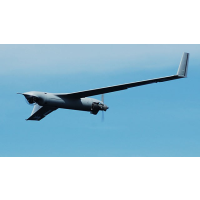U.S. Energy Firm’s First Arctic Drone Mission Paves Way for Controversial Drilling
 ScanEagle drone (photo: PRNewsFoto, Insitu, AP)
ScanEagle drone (photo: PRNewsFoto, Insitu, AP)
Wherever drones fly, controversy seems to follow. This time, it’s not in war or to battle insurgents, but to help open the Arctic Ocean to oil exploration.
Oil company ConocoPhillips on September 12 launched the first commercial drone flight over the Arctic to survey the Chukchi Sea. The flight took place only after the Federal Aviation Administration (FAA) gave its approval to use unmanned aerial systems (UAS) for such purposes.
The company launched a small, 40-pound ScanEagle drone, one of four onboard a research vessel, for a 36-minute flight over international waters to test the unmanned craft’s sensors and navigation system. The drone’s use in the Arctic will be to monitor possible threats and environmental risks, such as gauging marine life activity (tracking whale movements) and ice sheet flow, in an effort “to meet environmental and safety rules before drilling on the sea floor,” the FAA said in a prepared statement.
The aircraft were purchased from Insitu Inc., a subsidiary of Boeing that manufactures drones for both civilian and military use. The ScanEagle has been used by the U.S. military since 2004 for surveillance missions.
In April—several months after Shell’s oil rig difficulties in the Arctic—environmentalists hailed ConocoPhillips’ announcement that it had decided against drilling in the region next year, which cited uncertainties of federal regulations as the reason. But now, only five months later, the company’s drone mission into the region suggests that its decision may have been reversed.
The Center for Biological Diversity, which opposes oil exploration in the Arctic, questioned whether the aerial surveillance would make drilling any safer.
“Watching from a drone or a hot-air balloon or an airplane won’t change a simple fact down below: Drilling in the Arctic is flirting with serious danger and an oil spill would be disastrous and impossible to clean up,” Rebecca Noblin, the group’s Alaska director, told Common Dreams.
The FAA, though, sees a positive future for drones in the area, saying the ScanEagle flights “are just the start of the FAA Arctic Plan.”
“Small UAS [unmanned aerial systems] in the Arctic can benefit many operations, such as scientific research, search and rescue, fisheries, marine mammal observers, oil and gas leaseholders and maritime route planners. The project is giving the FAA and industry needed experience and a path forward to certify UAS for more commercial operations, both in the Arctic and elsewhere,” the FAA said.
-Noel Brinkerhoff
To Learn More:
Drones in the Arctic: New Tools for Risky Drilling? (by Andrea Germanos, Common Dreams)
Conoco in Landmark Alaska Drone Flight (by Ed Crooks, CNBC)
FAA Opens the Arctic to Commercial Small Unmanned Aircraft (Federal Aviation Commission)
State Sues Two Oil Companies over Underground Tank Violations at 560 Gas Stations (by Ken Broder, AllGov California)
Arctic Oil Rig Grounded Dangerously in Alaska (by Noel Brinkerhoff, AllGov)
Shell Safety Testing for Arctic Drilling Blowout Lasted for Only 2 Hours (by Noel Brinkerhoff, AllGov)
- Top Stories
- Unusual News
- Where is the Money Going?
- Controversies
- U.S. and the World
- Appointments and Resignations
- Latest News
- Trump to Stop Deportations If…
- Trump Denounces World Series
- What If China Invaded the United States?
- Donald Trump Has a Mental Health Problem and It Has a Name
- Trump Goes on Renaming Frenzy






Comments